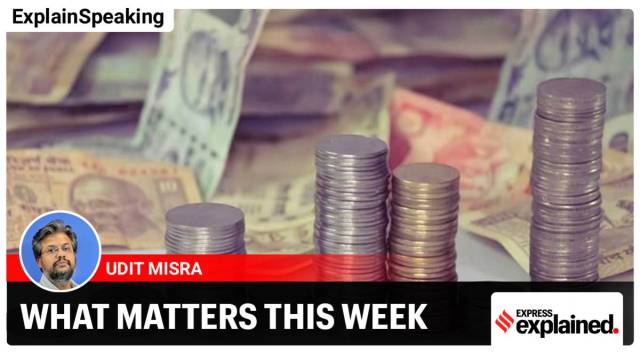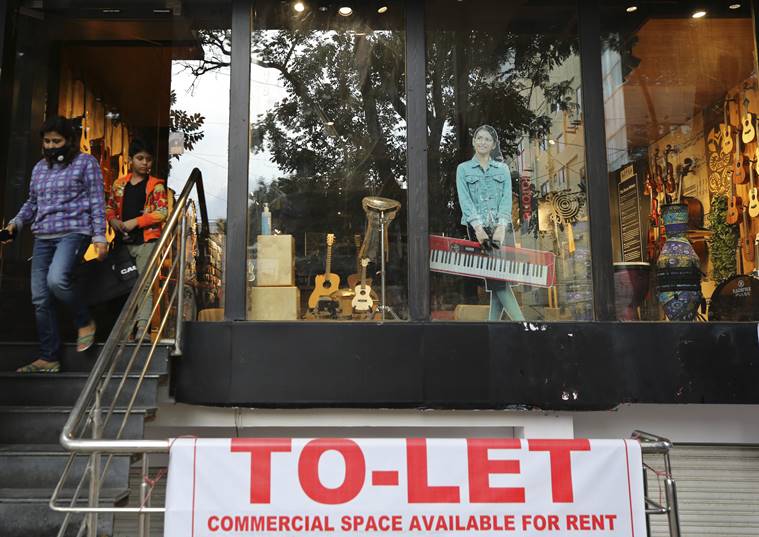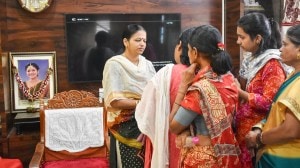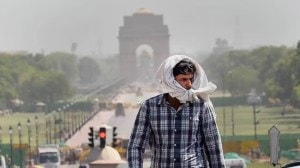- India
- International
ExplainSpeaking: What is driving Indian economy’s growth worries?
RBI’s internal report recommends allowing large corporates to start their banks but experts are unsure if that is a desirable move.
 If this economy grows at an average annual rate of just 5 per cent (instead of 8 per cent) from Year 3 onwards, then it will take more than three years to reach the 116.6 units level of GDP.
If this economy grows at an average annual rate of just 5 per cent (instead of 8 per cent) from Year 3 onwards, then it will take more than three years to reach the 116.6 units level of GDP.Over the past few weeks, there has been much talk about how the Indian economy is fast coming out of its technical recession. Such hopes are not without substantial justification — both in terms of the revival of economic activity within India as well as news of Covid vaccines being discovered.
There is an expectation that even if the Indian economy contracts in the current financial year — by, say, 10 per cent — it will perhaps grow by roughly the same percentage in the next financial year — 2021-22.
But it is important to remember that in times of such stark contractions and growth, one should not only focus on the GDP growth rates but also look at the absolute level of GDP. [The GDP or the gross domestic product is the money value of all goods and services produced within the country in a financial year.]
For instance, if an economy’s GDP were to contract by 10 per cent — from 100 to 90 units — in Year 1 and then grow by 10 per cent in year 2 — from 90 to 99, then at the end of the second year, the absolute level of GDP will still be lower than what it was two years ago.
Had the initial contraction not happened, this economy’s GDP would have been 116.6 units — assuming an 8% average annual growth — at the end of Year 2.

From 99 units in Year 2, however, even if the economy resumes its 8% growth momentum as soon as it enters Year 3, it would require two additional years to even come close to the 116.6 units mark.
But, after a crisis, an economy can struggle with regaining its growth momentum. This may be especially true if the economy was losing momentum even before the crisis and/or if the response to the crisis was not adequate for the economy to quickly regain its lost momentum.
If this economy grows at an average annual rate of just 5 per cent (instead of 8 per cent) from Year 3 onwards, then it will take more than three years to reach the 116.6 units level of GDP.
A new report by Oxford Economics suggests something similar happening to the Indian economy. Oxford Economics has forecast that India’s potential growth is likely to average just 4.5 per cent between 2020-2025, as opposed to its pre-virus forecast of 6.5 per cent. It is important to note here that 6.5 per cent is already lower than the average annual growth (6.8 per cent) India achieved since economic liberalisation in 1992.
The main culprit for this fall — from 6.5 to 4.5 per cent — in potential growth rate, according to Oxford Economics, is India’s weak fiscal response, which magnified the structural drags. In other words, because the Indian government did not spend enough directly to push up the economy, the recovery would be slower.
As a result, India will likely be the worst affected among major economies of the world.
“GDP per capita to be 12 per cent below our pre-virus baseline even in 2025, implying the largest amount of scarring among major economies globally,” notes the analysis.
“It’s likely that headwinds already hampering growth prior to 2020 — such as stressed corporate balance sheets, elevated non-performing assets (NPAs) of banks, the fallout in non-bank financial companies (NBFCs), and labour market weakness — will worsen,” said Priyanka Kishore, head of India and South East Asia Economics.
Also from Explained | What are the economic implications of India opting out of RCEP?
 A woman and a child exit a music store as a to-let sign is displayed on a floor below vacated by the tenant recently in Bengaluru (AP Photo/Aijaz Rahi)
A woman and a child exit a music store as a to-let sign is displayed on a floor below vacated by the tenant recently in Bengaluru (AP Photo/Aijaz Rahi)
These assessments and forecasts are important since the Union Finance Ministry has just started the process to frame its next annual Budget. 📣 Click to follow Express Explained on Telegram
Most of the attention in the past week, however, was on the state of banking in India. For one, the collapse of Lakshmi Vilas Bank and its proposed merger with DBS Bank rattled depositors and stock market investors alike.
The banking sector regulator, the Reserve Bank of India, had some relief when it became the first central bank of the world to have a million followers on Twitter.
But the most substantive news out of RBI was the report of an Internal Working Group (IWG), which was formed in June to review the existing guidelines regarding the ownership of Indian private banks. The IWG has made several recommendations that are expected to raise the prudential norms in Indian private banks.
These include suggestions such as
- disallowing bank promoters from pledging their shares in such a manner that breaches the prescribed minimum threshold
- no longer allowing ADRs/GDRs (negotiable certificates that work as a proxy for shares in foreign markets) issued by banks to be used by any shareholder to indirectly enhance their voting power
- raising the minimum initial capital requirement for new banks
- tightening the requirement for banks to list in the stock markets
- asking banks, which run side businesses, such as insurance and mutual funds, to shield their banking operations by adopting a financial holding company structure.
Almost all of these are expected to make private banks function safer.
The IWG has also recommended that regulatory norms be harmonised across entities. In other words, if the initial capital requirement for a new bank is raised then all existing banks, too, should comply with the higher standard.
However, there are a couple of recommendations that might trigger some debate.
Read | Raghuram Rajan, Viral Acharya: Proposal to allow corporate houses to set up banks a ‘bombshell’
The first one relates to the cap that RBI imposes on a private bank promoter’s stake after a period of 15 years. At present, this cap is 15 per cent of the paid-up voting equity capital. But some have been unhappy with this limit. Most noticeably, Kotak Mahindra Bank had even taken the RBI to the Bombay High Court on this matter.
The second one relates to allowing large companies and industrial houses to become promoters of banks. Linked to this is the suggestion to allow Non-Banking Financial Companies promoted by large corporates to be turned into banks.
 Customers wearing protective masks shop during the festival of Dhanteras at the Lajpat Nagar market in New Delh (Photographer: Prashanth Vishwanthan/Bloomberg)
Customers wearing protective masks shop during the festival of Dhanteras at the Lajpat Nagar market in New Delh (Photographer: Prashanth Vishwanthan/Bloomberg)
Allowing large corporates to start a bank has always been a tricky issue. Most major economies, except the United States, do not bar them. But India does not allow them to float banks and, on the face of it, for good reason.
For one, many experts believe that corporate governance in India is still not good enough and it is quite possible that such a promoter’s non-financial business and transactions adversely affect such a bank’s functioning. To be sure, IWG reached out to its set of experts and found that “all the experts except one were of the opinion that large corporate/industrial houses should not be allowed to promote a bank”.
The obvious counter, however, is that if we allow NBFCs by similar corporates then why not banks. After all, banks are more tightly regulated than NBFCs.
The key concern underlying both these proposals is to balance the need for growth and new banking avenues with the prudential norm of having more diversified ownership in private banks lest one dominant owner abuses the system to the detriment of many.
These IWG recommendations will likely continue to stroke conversations in the coming weeks.
Stay safe,
Udit.
More Explained
EXPRESS OPINION
Apr 26: Latest News
- 01
- 02
- 03
- 04
- 05











































